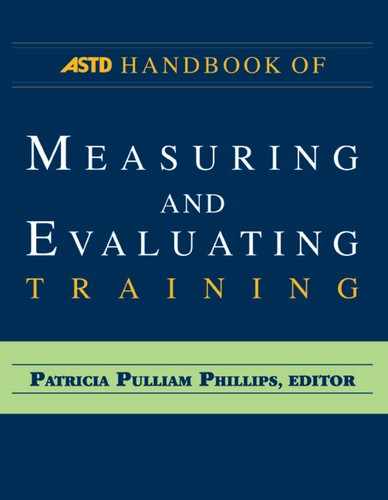 Epilogue
Epilogue
What, then, are the “learnings” from these interviews? What forecast for the future of training evaluation and measurement can we derive from the comments of these legends?
- Standing on the shoulders of those who came before, the history of measurement and evaluation is evolutionary, not revolutionary.
- Many of the innovations came from examining what had been done and simply asking, “why” and “what if?”
- Donald Kirkpatrick, Jack Phillips, and William Rothwell use the same analogy about proof and evidence before a “jury” that increasingly holds our fate in its hands.
- A great consensus exists that there is (and will continue to be) an emphasis on evaluation data at the higher levels, moving beyond reaction and learning (although still important) to behavior change and business/financial impact.
- Dana Gaines Robinson articulated the belief that behavior change that drives results is the only real determinate of value.
- We need to make evaluation a critical element of the front-end work, never an afterthought.
- There is no lack of tools, methodologies, case studies, and now technology to assist us, but they are not a substitute for clear thinking about what we are trying to measure and why. Evaluation is less about the methodology chosen but more about the rationale behind the selection.
- The field of evaluation is not without differing views on key issues. For example, William Rothwell says his executives suggest training professionals not evaluate their own programs; yet, Jack Phillips’ research states that executives want the evaluation data. So what should training professionals do? They need to approach evaluation methodically and systematically and ensure they make conservative assumptions. They need quantitative and qualitative data along with financial and nonfinancial data. Augmenting data with quotes, examples, and specific case examples from highly-regarded executives and stakeholders can not only help drive home the impact, but can help mitigate executive concerns about objectivity. This is what gives results credibility and helps senior leaders trust the evaluation data.
- Partnership with and communication to senior leaders is at the heart of long-term success.
- Both Robert Brinkerhoff and Roger Kaufman look to a future when evaluation also encompasses the impact on society and “the greater good.”
- William Rothwell’s “Theory of Visible Activity” explains a lot about executive perceptions.
- Dana Gaines Robinson’s experience notwithstanding, evaluation work does not always lead to finding your soul mate.
- Among all those interviewed, there was a sense of appreciation for the journey so far, for the many who have embraced the methodologies and practices that shape their evaluation and measurement work, but there was also concern for the relatively small percentage of members of our profession who do this along with a frank assessment of how much further we need to go.
There is no way to capture the depth and breadth of the contribution to the profession, in particular to the field of training evaluation and measurement, of these legends—these giants—in a book chapter or in brief interviews. To be fully appreciated, the richness and complexity of their thought leadership must be experienced through reading their works, studying with them if you are so fortunate, and then applying the concepts and tools to the work we do for our organizations and clients. Perhaps this chapter offers a roadmap for your own continued exploration or a blueprint for the next iteration of innovative thinking about evaluation so that, 20 years from now, the next series of interviews with “legends” will include your voice.
It was my privilege to serve as the interviewer. I have been a beneficiary of their thought leadership and practical frameworks for many years, and, if I have been able to effectively serve the clients and corporations for whom I have worked, it was due in large part to the pioneering work of these legends. I remain deeply grateful to Patti Phillips for the opportunity to be involved with this definitive work and to stand on her shoulders as well for many years to come.
